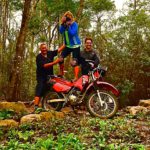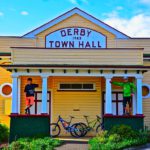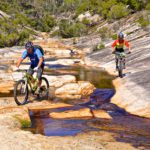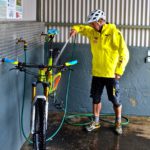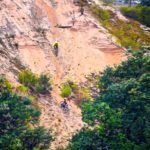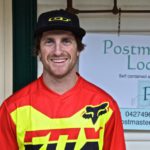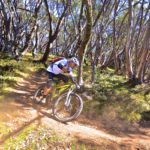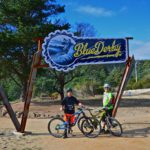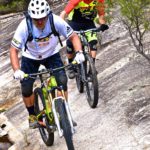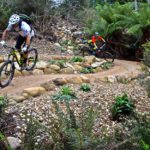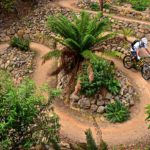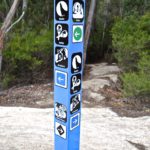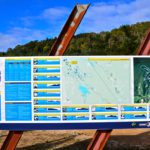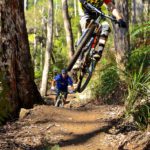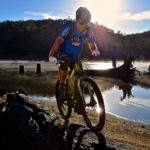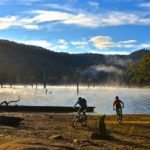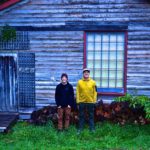Tasmania, Australia 2016
with Hans Rey and Tyler McCaul
Words and photos by Carmen Freeman-Rey
Chances are that in the past, if you had heard of Tasmania, it was for one of the following reasons; It is a decent sized island 150 miles off the big island, Australia, there is a tough little creature that lives only there, called the Tasmanian Devil, immortalized by the “Looney Tunes” cartoons, there are a lot of poisonous snakes and an abundance of wilderness for them to thrive in.
That was then, but this is the now and now there is something new that is putting Tassie on the map. Mountain bike trails. Not just any mountain bike trails either, rather the kind that are Nirvana to those on the hunt for flow, for a roller coaster ride of dips and peaks and beautifully carved berms, that allow you to pump, rail and be filled with exhilaration as you suck up the dirt beneath your tires with scarcely a pedal stroke in between.
Ahhh, but what about the ups, the painful part that a rider has to endure in order to have the reward of the rush? Imagine perfectly sculptured switchbacks, not too tight and not too steep, hardly any effort at all. Imagine these turns and uphill trails formed around and between giant eucalyptus and tree ferns, hugging the sides of gigantic granite boulders. Imagine trails that allow little sections of rest in between the pedaling. You don’t have to imagine any longer, for this kind of riding is here and these very trails are the new thing putting Tasmania on the map. These are the purpose constructed, Glen Jacobs designed, World Trail built, Blue Derby bike trails, embracing the temperate Rainforest around the small former mining town of Derby, County Dorset, population 250.
Flow, the magic word for mountain bikers, the term “Flow” has been around for a long time, but people’s perception of flow varies greatly. Back in 2008 Hans Rey along with European trail building impresario Diddie Schneider coined the phrase “Flow Country”, for a particular kind of flowing trail. The idea was to create purpose built trails where all levels of bikers could experience the euphoria of fluid riding and this would get more people on bikes. To quote Hans Rey, “Flow Country is never steep, never extreme, never dangerous, a trail that anyone can ride on any kind of mountain bike, pros and beginners alike, only their speed and style makes the difference in how they experience the rollercoaster of Flow”. This definition is critical; when a person sees a trail marked “Flow Country” they know exactly what they are getting, with no scary surprises. But more about this later….
Mountain biking is a culture, a lifestyle and even a club, not an exclusive club, but it is a selective one. You can do the sport in pretty much any country, you don’t even need actual mountains, you don’t have to pay a membership fee and once you have your equipment, it is pretty much free. But it is selective, selective because you have to put in the times, you have to have at least a little nerve, a certain amount of fitness, a certain amount of commitment and you have to not mind getting beaten up every now and then.
There is a camaraderie amongst riders, stories are swapped, encouragement given, tips and guidance passed on, if a rider needs help, there is always a good Samaritan on the trail ready to give it. There is a persistence involved, practice, ride and ride more, your heart pounds as it works hard to circulate the increased oxygen we suck in on the uphill and pounds with the fuelled adrenaline rush of the downhills.
But as much as mountain biking is fun, it is also an economy thriving tool for forgotten communities. Across the world we are seeing small towns with no future, now have an exciting future. This is something that the town of Derby, Tasmania, Australia, is experiencing first hand thanks to the Blue Derby biking trails network. They now have a town slogan, “Derby, a historic past with an exciting future”, they got that right.
In March 2016, I was lucky enough to travel to Tasmania with GT Bicycles athletes, Hans Rey and Tyler McCaul and together we experienced this trail candy. Whilst at the same time, I observed how an all mountain rider and adventurer like Hans and a top freerider and Red Bull Rampage veteran like Tyler could enjoy 80 km of Flow that Blue Derby has to offer. But first, it is time for a little history….
Derby is a little town on the banks of the Ringarooma River in the county of Dorset, located in the northeast of Tasmania. The first settlers arrived in 1874 and with them, a valuable discovery was made, tin. With the Krushka bothers, tin mining commenced and in 1885 the settlement created by mining brothers was given a new name, Derby. The mine was re-named too; The Briseis Mine and it became one of Australia’s largest producers of tin, producing 120 tons a month. This tiny settlement grew to have a population of 3000 and with this came the infrastructure to support it, including a school, hospital, 3 hotels, 3 churches, 3 grocers, 2 bakers, a boot maker, draper and jeweler. The town thrived and the future looked good. Then in 1929 disaster struck. On April 4th after torrential rainfall, the river swelled and the dam so necessary for mining, burst. Millions of gallons of water rampaged down on to the town of Derby decimating all in its path and taking 14 lives.
The mine re-opened in 1934, but things were never the same again and it could not survive such destruction and devastation and so in 1948, the mine shut down for good and so did Derby’s economy. Unemployment reigned, with no jobs, people moved away, businesses closed and the population shrank to merely hundreds. For 6 decades it seemed that Derby had no future; that it would simply continue to shrink and eventually die out completely. That is until in s2009 when some people had a very bright idea, a network of purpose built mountain biking trails, trails of a world class standard that would entice the world to ride them.
Whilst standing outside the Postmaster’s Lodge on a wet Friday afternoon waiting to photograph Hans and Tyler riding a steep chute opposite, Tim Watson the General Manager of Dorset County Council explained to me how this all came about. Back in 2009 the Tasmanian Government published the ‘Tasmanian Mountain Bike Plan’, this highlighted North East Tasmania as one of the priority areas for the development of mountain bike trails. Subsequently in 2011, the Northern Tasmanian Development (NTD) commissioned its own report titled, ‘Mountain Bike Tourism Potential in Northern Tasmania’. They then enlisted a trail building company, ‘Dirt Art’ to come up with an “Eastern Mountain Bike Plan” that would involve approximately 80km of trails. However this plan would have seen trails spread over three separate locations, including, Blue Tier, Mount Stronach and Hollybank. That was when in 2012 the NTD approached Tim Watson to find out whether Dorset Council would be interested in being a part of this project.
Tim not being a mountain biker himself at the time, knew that he had to do some research looking into what the likes of Whistler, Rotorua and other mountain biking destinations around the world had to offer. What would it entail logistically, was it viable, what would it cost, what do mountain bikers want and need, who would build the trail network and crucially, could they get funding? “As a result of this research we became convinced that the dispersed trail network that was being proposed would not work because it did not involve a trail head in or close to any town and also lacked a critical mass of trail in any one location. We also knew that it was unrealistic for people to ride 15km in one location, jump in their car and drive 40 minutes to get to the next location to then ride another 15km-20km of trail”, explained Tim. It seemed very clear to Tim that the trail head must be located in the town so that no driving would be necessary once there, he knew that there had to be facilities, an infrastructure and enough riding to keep people there for more than one day.
On the advice of a local Elite Marathon XC rider, Ben Mather, Dorset County Council started to take a good look at Derby. Ben felt that because of the soil conditions, elevation and potential for that desired “critical mass of trails”, Derby would be the perfect location. There was considerable opposition to this idea, but in the end, as Tim put it, “We laid it on the line, we wanted Derby to replace Mt. Stronach in the 3 location network, or we were out”.
Enter Glen Jacobs and his company World Trail. Glen, a man who always has a smile on his face, time to chat to anyone and seems to know everyone. He is passionate about the outdoors, nature, mountain biking and building trails. In Hans Rey’s words “Glen is one of the foremost trail builders, not just in Australia, but in the world, in part because of his deep knowledge and understanding of mountain biking and what makes good trails, but also how to build them. He is extremely good at passing this knowledge on to his crews, training and teaching them how to do it right.”
With Glen’s outline plan on the table, along with the economics of it all, in April 2013 Tim and NTD started the process of chasing funding, with an application in to the Federal Government’s Grants Program. Tim then hopped on a plane to Rotorua, New Zealand to find out a little more about what all the fuss about mountain biking was really about. I should point out, back then, Tim had only ridden a mountain bike a few times, he wanted to understand the culture, needs, wants and have answers to all of the questions he had been previously asking himself. “After the trip I was absolutely hooked, couldn’t wipe the smile of my face for about a week”, said Tim. He also came away with a lot of those answers and so with the news in June 2013 that they had their funding of AUS $2,450,000 he and Glen Jacobs were ready to begin.
Mountain biking has become a big part of my life for many reasons, many of my friends are riders, it is one of my hobbies, my work and of course my husband has been a pro-rider for over 30 years. When people ask me, “Do you ride?”, I am never quite sure how to answer, yes I ride, but at what level and how does one judge that level. Clearly I am no Hans Rey or Tyler McCaul; my guess is that I would be classed as intermediate. There is a lot to love about mountain biking, you are outdoors in some stunning and often wild country, you feel a sense of achievement after an uphill and it keeps me fit and strong, I love the adrenaline of the down-hill and the sense of accomplishment when riding a section I may have walked previously and I even wear the scars as badges of honor. But…living in California, I am woefully aware that our trail systems could be so much better and I know I am not the only one.
Hans Rey has ridden his bikes on trails in over 70 countries, he has been working as a consultant and advocate of purpose built trails in Europe for 15 years, clearly he has a depth of knowledge about what a good trail should be and what it shouldn’t. Hans also has an understanding of the huge economic impact great trails can have on ski resorts during the summer season and also on small towns like Coed Y Brenin in Wales and Derby in Tasmania. You don’t need big mountains to have mountain biking trails, hills will do, but if you have great trails and infrastructure, that is even better, as Hans puts it “I believe firmly that purpose built trails will be a big part of the future for mountain biking and the industry, bringing more people to the sport. Build trails and people will come and they will spend money”. Derby is just now experiencing this, whereas Coed Y Brenin has over 20 years of measurable results to back this up.
“Those trails have to be built right, it is not enough to be a mountain biker with a digger and move dirt”, explains Hans. “This must be well thought through with attention to detail, we must cater to a large demographic of riders, their styles and capabilities, no corners can be cut, they must be built sustainably”.
Which brings us back to Flow trails; Hans along with Glen Jacobs and German Trail builder Diddie Schneider consider the concept of Flow as being implementable not just in mountain resort areas with lifts and bike parks, but also in areas with small towns and even small hills. A Flow like this, “ It is hard to describe the amazing feeling of riding a perfectly built “Flow Trail”, the features of the trails are perfectly aligned like a symphony, with a continuous rhythm and harmony, the feeling of weightlessness, the G Force coming out of a berm at the right speed is like riding a rollercoaster, it is bliss and addictive, leaving you craving more no matter how fatigued you are”. This feeling is no longer only reserved for the expert rider, it can be experienced by any level of rider, if a beginner, you take it slow learning some skills along the way, if an expert, then you take it faster perhaps taking different lines, sucking up the pump track like features of rollers, railing the berms and even getting some air when you hit those strategically located B-lines.
September 2015, Glen Jacobs is staying with us in Laguna Beach, definitely not the home of Flow. After an evening talking about the concept, Glen produces his phone and shows us some photos and video of the Blue Derby trails network, we were amazed by what we were saw. Not just properly built trails, but trail art. “Wow”. I said, “I seriously want to ride those”. Glen replies, “Look mates, let’s get you out to Tassie, both of you, Carmen, you can take the pictures”. Of course I thought that this would be highly unlikely, it’s a long way away and Hans’ travel schedule is always insane. But Glen, not one to just talk made it happen and 6 months later Hans and I were headed to Tassie where we would meet up with our cameraman, Jase McAlpine and Freerider Tyler McCaul.
Tyler, as most people know, is an incredible rider, a native Californian and with several Red Bull Rampage competitions under his belt, he is a specialist at anything that involves big drops, jumps and sick moves that have him flipping and spinning his bike. What some may not know, is that Tyler also likes to carve a little dirt himself, shaping and molding jumps for the tricks and smooth berms for dual slalom. It was going to be interesting to see what Tyler thought about the riding experience at Blue Derby and how the network was built.
So what did Tyler have to say about Blue Derby? “The trails are awesome! What surprised me the most were how much Blue Derby has to offer and the different terrains in the area. You can ride a trail that takes you through a Rainforest full of Tree Ferns and black dirt, then all of a sudden you link on to another trail in the Eucalyptus trees with a different type of dirt and completely different kind of environment. The climbs were surprisingly enjoyable and wound around so much that sometimes you didn’t even feel like you were climbing. It gives you a chance to enjoy your surroundings rather than being so out of breath that you just want to get to the top and have the climb over with.
World Trail’s attention to detail with drainage and making the trails sustainable means that these trails are built to last! Glen mentioned that they hike the whole area before breaking ground to make sure that they are putting the trails in the best possible path, where it will flow the best, where you can experience a waterfall, or ancient Gum Tree, it definitely shows that they put a lot of thought into what they built. The trails are suited for every level of rider and built to be safe with no blind drops or anything that could get a beginner into trouble, but at the same time, someone who falls into the advanced category can still go fast and have a blast”.
I asked Tyler whether he, with his style and level of riding had fun. “It’s safe to say that I definitely did have fun on the Blue Derby trails, it is a different environment to say Whistler Bike Park and for this reason I found it super refreshing. At Blue Derby, it isn’t about hitting the biggest jumps, or riding the most technical downhill. It’s about getting out for a peddle and getting lost in one of the forests that Tasmania has to offer, about meeting people, seeing new sites and riding an insane amount of really well built trails along the way”.
Like Hans, Tyler feels that purpose built trails that are attainable for all skill levels in his words, “make it even more awesome and will get even more people into the sport of mountain biking. That the Tasmanian Government put effort and resources into such a project is an awesome thing and I hope that other countries, states, towns etc catch on and do the same thing”. When asked about “Flow”, Tyler said, “It is a different kind of experience to an extreme bike park, but that doesn’t mean that it isn’t fun, it is just a different type of fun and you may find a new love for more user friendly trails where you are not necessarily scaring yourself sh!tless around every corner”.
As for me and my intermediate riding level along with 25lbs of camera equipment on my back? I can hand on heart say that I had a blast. The setting is beyond stunning, as a photographer, I was spoilt for images that I wanted to capture through the lens, the surface of the dirt was smooth and compacted, the berms and rollers gave me a thrill, the pump track like whoops made me literally “whoop”, the up-hills were never a grind and there was nothing I could not ride. I came away each day euphoric and just like Hans and Tyler, with a huge smile on my face feeling like a 10 year old that had just been let loose at the fairground.
But getting back to the concept of “Flow Country” and purpose built trail networks, how they should be created, how such a thing can impact a local economy and what the locals make of it all. There are several vital components; possibly the three most crucial ones in Hans’ opinion are “location, planning and execution”. Spending time in the village of Derby, talking to locals, visiting the outlying villages (well, the pubs at least, never underestimate the value of a pub after a long day riding), I want to add to this; community, support and embracement.
As Tyler noted “I didn’t know what to expect in terms of the locals attitudes toward the creation of the trails network in Derby. In a small town like this where not much has changed in the last few decades, it could really go either way. The locals could either be wary of change and not very welcoming of outsiders coming into their town, or they could be stoked on the tourism and economy boost that it’s giving their community, and it seems like that’s exactly what’s happening! Every single local that we talked to was so happy about the changes that were going on in their community all thanks to the Blue Derby trails, and they seem to be embracing the culture as a whole and welcoming anyone and everyone to come check out what they have to offer. It’s cool to see”.
I myself heard numerous accounts about just how much the community is benefiting commercially from having such a great trail network and how good they think it is that the mountain bikers are coming, not just to Derby, but to the surrounding area too. Situated on the main street in the heart of the town right beside the free bike wash station, and showers and the Vertigo MTB Shuttle Service is a café called The Corner Store; the co-proprietor Michelle Rowe explained to us that not so long ago, she would be twiddling her thumbs with barely half a dozen customers a day crossing her threshold. “Now I can barely keep up, there can be 20 for breakfast, 40 for lunch and more later on for dinner”. Indeed, she does make a mean coffee and a tasty egg and bacon sandwich. You can tell when talking to Michelle that she is a grafter and a savvy businesswoman; she isn’t one to overlook an opportunity to make her business more successful. When mountain bikers wanted dinner, not just breakfast and lunch, she opened for dinner. She saw the potential in having a shop right there in the café that sells bike accessories, tires, gloves, pumps etc and includes a bike rental station. Smart woman.
One of the few businesses that survived the decades of decline in Derby was the Post Office. A couple of years ago Shannon Rattray bought the business along with the run down Postmaster’s Lodge from wherein it is housed. Shannon, like Michelle saw an opportunity at a time when it wasn’t yet certain just how successful the trail network project would be. She had faith that the riders would come, hikers and trail runners too. Shannon embarked on a restoration project to bring back the 100 years old Postmaster’s Lodge to its former Edwardian glory. Stripped wooden floors and stained glass windows have been lovingly preserved. A deceptively large and charming house, it also boasts a secure bike room, with workbench, tools and bike racks. This was going to be our home for the next 5 days and we couldn’t have been happier. Shannon greeted us personally with a big smile and the smell of freshly baking bread in the kitchen, yes she even baked us bread! I have a feeling that Shannon’s investment will turn out to be an extremely good one, not only is the Postmaster’s Lodge constantly booked up, the house prices in Derby are shooting up, this in a town that not long ago, no one wanted to buy into. That is the power of marvelous mountain biking trails.
You have heard about the aesthetic beauty of this place, the exquisite symphony of the trails, the euphoria, the craftsmanship and creativity of a master trail builder, one who creates trails as Hans puts it, “you ride twice, with your eyes and second, with your body. This mastery is achieved through trial and error, experience, and immense knowledge of topography, geology, machine ands tool handling and dirt. Dirt, that is another word that you will hear often from the lips of mountain bikers; the dirt was good, dirt was bad, dirt was dry, dirt was awesome, and dirt had good traction. But how does Glen Jacobs make his dirt, dirt that everyone wants to ride on? He has rules and methods and they are adhered to meticulously. Glen insists that his trails have time to cure, a trail is built, berms sculptured and then they wait, they wait for the rain and approximately 6 months for the dirt to settle and compact naturally. Woe betide any over eager riders that refuse to accept this waiting rule, the riding community police these ‘trails-in-waiting’ and will kick you out in a heart beat There are no nasty ruts on a Glen Jacobs trail (unless you are riding a designated Black Diamond run for experts only which Blue Derby also has to offer), this is because he builds with just the right amount of camber to allow a natural run off for water. If a section is boggy, sandy or unstable in any way, he lays an ingenious system of concrete “rocks” attached to a mesh backing which holds them together securely in place like a mat. Trust me, they don’t move, wobble or skitter and we rode them for 2 days having no idea that they were man made and not part of the natural geoscape until Glen told us.
On top of his trail building ingenuity, he is a trail marking genius. The trailhead greets you with free parking, and clearly illustrated maps, listing quirky names like “Flickity Sticks”, “Howler” and “Dam Busters”, alongside these names are descriptions of the trail, the length and the difficulty rating; easy, intermediate, difficult. Then once you are out there in the wilderness, you may be reassured that at every trail merger and intersection, you will be met with a clear marker giving you the options and directions.
Glen has many “Glenisms”, one of my favorite terms is CRC, Climb, Rest, Climb, as Glen puts it “As we design a trail system we insert the CRC system when we need to gain elevation. We never allow a trail to continuously grind up a steep hill, (unless it is specific Black Diamond trail or a race track). The CRC allows for a rider who has climbed for a few minutes, to have a descent on a climb, even if only for 20-30 seconds. Sure we throw away 20% of the entire section a rider has climbed, but it allows for regeneration and rest on the way to the top. Depending on the entire climb, we usually throw these rests in every few minutes, allowing for a way more enjoyable ride overall”. This makes perfect sense to me.
Tim Watson told me that, “These trails are not just about Derby; they are about Dorset County and the tourism visitation we are getting in the north”. I will go farther than this, these trails are not just about Derby, or about tourism growth in Tasmania, they are about what the future of mountain biking can be world-wide, they are an example of tourism growth that so many resorts and towns can aspire to. Even if they are already a popular biking destination, they can be even more successful and appealing. Often people can’t imagine anything different or anything better until they experience it. Well, maybe it is time for a lot more places to take a leaf out of Derby’s book.
To round off this ‘Tale of Blue Derby’, I would like to end with another Tim Watson quote, “For Derby the trails have arrested the terminal decline which commenced in 1940 when the tin mining operations ceased. More importantly the trails have given the North East hope again when all hope seemed lost”. Not bad eh? The power of a bicycle, who would have thought that something so much fun, could bring a town back to life again. It is your world, ride it and have a blast!
Nearest Airport: Launceston (LST): regular flights to and from Melbourne.
Bike shuttle and rental service: Vertigo MTB Australia http://www.vertigomtb.com.au
Accommodation: The Postmaster’s Lodge, 59 Main St. Derby.
Breakfast and lunch: The Corner Store http://www.thecornerstores.com.au/locations/derby

